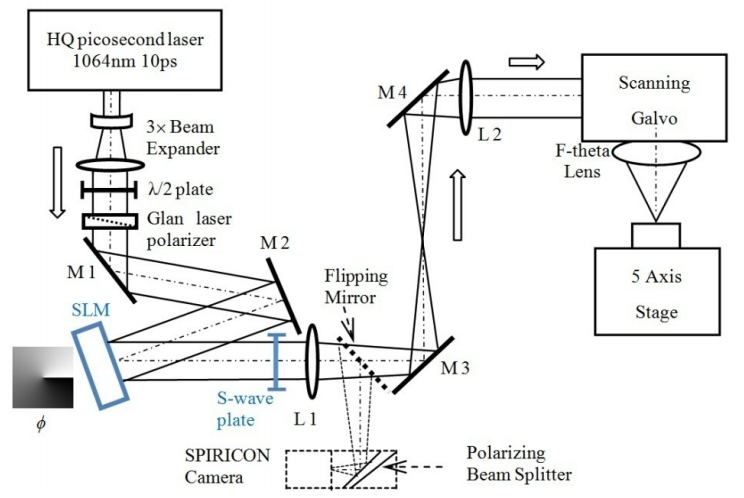May 18, 2015 report
Researchers use beams of polarized light to carve intricate patterns on disks

(Phys.org)—A team of researchers working at the University of Liverpool in the U.K. has created some interesting looking disks using some of the unique and exciting properties of light. In their paper published in the journal Optics Express, the team describes the process they used to create the disks and why they believe their experiments will lead to a better understanding of the angular momentum of light.
In this new effort, the researchers fired a linearly polarized beam (where the electric field oscillates in a single steady direction) through a special type of plate which resulted in a beam that could be radially polarized (where a beam forms a line from the center to the edge) or (by rotating the plate 90 degrees) azimuthally polarized (where an electric field is at right angles to radial beam lines and forms concentric circles.) But instead of choosing one or the other approach, the team set the plate at intermediate angles multiple times, which resulted in a composite of both types of beams during each run. The beam that came out, the researchers noted, could be described as a logarithmic spiral that could be changed by altering the degree of plate rotation, to more strongly reflect radial or azimuthal polarization.
Next the team fired the altered beams at a series of shiny steel disks, which resulted in very small spiral grooves being carved (at right angles) into their surfaces—in similar fashion to the way old phonograph records were made—some also eerily resembled human fingerprints. The team notes that the spirals that resulted had a spacing that was comparable to a wavelength of light, and because of that, might be useful for encoding information or for optical tomography applications or even for imaging and data storage. They also suggest their process could be useful for studying light in new ways, such as in analyzing what happens when orbital angular momentum is added to the beam of light, adding that their experiments thus far have suggested the presence of spin angular momentum, which suggested further that some orbital angular momentum had been changed to angular momentum.
More information: Tailored optical vector fields for ultrashort-pulse laser induced complex surface plasmon structuring, Optics Express Vol. 23, Issue 10, pp. 12562-12572 (2015) DOI: 10.1364/OE.23.012562
Abstract
Precise tailoring of optical vector beams is demonstrated, shaping their focal electric fields and used to create complex laser micro-patterning on a metal surface. A Spatial Light Modulator (SLM) and a micro-structured S-waveplate were integrated with a picosecond laser system and employed to structure the vector fields into radial and azimuthal polarizations with and without a vortex phase wavefront as well as superposition states. Imprinting Laser Induced Periodic Surface Structures (LIPSS) elucidates the detailed vector fields around the focal region. In addition to clear azimuthal and radial plasmon surface structures, unique, variable logarithmic spiral micro-structures with a pitch Λ ∼1μm, not observed previously, were imprinted on the surface, confirming unambiguously the complex 2D focal electric fields. We show clearly also how the Orbital Angular Momentum(OAM) associated with a helical wavefront induces rotation of vector fields along the optic axis of a focusing lens and confirmed by the observed surface micro-structures.
via Nanotechweb
Journal information: Optics Express
© 2015 Phys.org





















